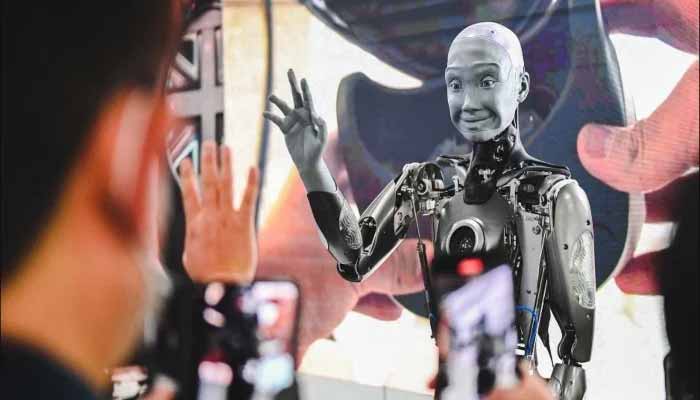
I return again and again with some reflections on a conference; this time, the Sahafi Summit in Lahore a couple of weeks ago. I realize it’s become a bit of a thing and this is probably the last open ‘conference’, but the summit was fun, inspiring, surprising in places and overall one of those rare events where you talk about journalism without wanting to bang your head on the nearest podium.
But before we get to the summit itself, let’s talk about AI, which also happened to be the main topic of this Sahafi GT in Lahore. So, AI: the big, scary, shiny thing that’s apparently coming for our jobs, our minds, and possibly our souls if you listen to the most dramatic comments around it.
I’ll start with the most honest thing I can say: if anyone thinks that AI is not yet used in journalism, they are either wrong or a big liar. There is no third option here. Let’s face it: everyone uses ChatGPT. The boldest among us wear Gemini. The more adventurous (or eccentric) use Claude. Someone somewhere is secretly using something called “Google AI Studio Beta Ultra Something” and pretending it isn’t.
I, for one, am a self-confessed newbie to most of these and don’t know how half of them work (something I need to fix ASAP). But I do use ChatGPT, not to write my stories, but to do what a very efficient personal secretary would do: help me clean up work lists, organize my course outline according to dates, reorganize bullets or data, etc. For me, it is a very good support tool. Nothing more (for now). But the point remains: AI is being used. It’s here, it’s everywhere. And we might as well stop pretending otherwise. And honestly, the real provocation here is that AI didn’t break journalism, it simply exposed the cracks that already existed: shrinking newsrooms, low salaries, the cult of speed over attention. In that sense, AI is the mirror and we don’t look very pretty in it.
Now let’s move on to the second big fear: AI will kill jobs. Is that true? To some extent, yes. Transcriptionists and translators have already felt the impact. Machines do a fabulous job at both, and they do it in milliseconds without asking for that annoying thing employers hate: a salary. But is this the first time technology has changed our work culture? Hardly. We had typists… and then we didn’t. We had composers… and then we didn’t. We had radio stars and then, as the song says, “video killed the radio star.” (By the way, it wasn’t really like that; radio reinvented itself: hello podcasts?)
So yes, jobs will change. Some will end. New ones will begin. The question is not whether technology changes us (it always does) but whether we are willing to adapt. Instead of panicking, what if we trained ourselves? What would happen if newsrooms offered workshops? What if, instead of railing against the machine, we learned to take advantage of it? Because the real danger is not that we lose jobs but that we are “disqualifying.” Relying too much on AI means young journalists can skip the fundamentals: interviewing, fact-checking, writing, building sources. I really worry about producing editors who have never edited and reporters who have never reported.
Which brings me to my third point: the real question is not whether AI is used but how it is used. Are you using him as a creative partner? An aid to research? A translator? A summarizer? Good. Are you using it as a shortcut so you don’t have to think, report or understand? Absolutely not right. Journalism cannot be automated because journalism is not typing. Journalism is judgment, context and the ability to distinguish true facts (yes, they are not the same). And in a world drowning in cheap, fast, low-quality content, perhaps the true value proposition of journalism is the opposite: slowness, depth, lived experience: everything that can’t be mass produced or “incited” in seconds.
And this is where the Sahafi Summit comes in, because these were precisely the things people were talking about. One of the strongest concerns came from the union panel, which spoke of job losses. And they are right to worry. Technology always reaches the most vulnerable first. But the answer, once again, is not to remain paralyzed by fear, but to reorganize, negotiate better protections, and demand training.
Then there were the students: my favorite moments of the two days. Let me just congratulate the Mass Communication guys at Punjab University for being so gracious and such good hosts. They asked some penetrating questions: What happens to art and poetry if AI can generate both? What about creativity? What happens to the writer’s voice? To me, these questions were hope, a sign that young people are okay. They are walking into the future not as passive consumers but as questioners. [As I tell my journo class: question everything].
My panel at the summit was about the “human spirit of journalism,” which sounds great but was actually a very informed conversation. I tried to say what I truly believe: the human spirit will survive this. Publishers will survive this. Because? Because you will always need a human head to make sense of human stories. You can’t write about a flood, a protest, a family tragedy, or a political moment without understanding the people around it. In countries like Pakistan, where much of our cultural and political history is based on oral narratives and journalistic testimonies, human memory is important. If anything, the rise of AI should push us to redouble our efforts in the most human parts of our craft: empathy, curiosity, nuance, responsibility and skepticism.
So here we are: at the beginning of a long, complicated, sometimes terrifying, sometimes exciting conversation. AI is not going away. Neither does journalism. And this conversation will continue: in classrooms, in newsrooms, at conferences and, yes, in columns like this one. And somewhere in the middle of all that, maybe we’ll figure out how to make this strange new world work for us.
PS: A big thank you to Media Matters for Democracy (MMFD) and Punjab University for creating something so carefully structured.
The writer directs the opinion articles section of this newspaper and teaches university students. She says things on X @zburki and can be contacted at: [email protected]
Disclaimer: The views expressed in this article are those of the writer and do not necessarily reflect the editorial policy of PakGazette.tv.
Originally published in The News



